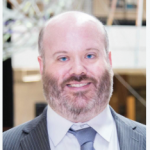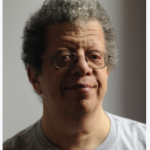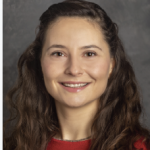Disabilities as Assets and Strengths
The Justice, Equity, Diversity, and Inclusion (JEDI) Outreach Group Corner is a regular component of Amstat News in which statisticians write about and educate our community about JEDI-related matters. If you have an idea or article for the column, email the JEDI Corner manager.
“My disability has opened my eyes to see my true abilities.” — Robert M. Hensel
 Shu-Min Liao is an assistant professor of statistics and a faculty facilitator of the “Being Human in STEM” course at Amherst College. Sparked by her disabilities, minority identities, and unusual lived experiences, Liao is passionate about STEM education research and DEI work (besides copula modeling for categorical data). She is currently part of both the JEDI Outreach Group and the ASA Committee on Statistics and Disability.
Shu-Min Liao is an assistant professor of statistics and a faculty facilitator of the “Being Human in STEM” course at Amherst College. Sparked by her disabilities, minority identities, and unusual lived experiences, Liao is passionate about STEM education research and DEI work (besides copula modeling for categorical data). She is currently part of both the JEDI Outreach Group and the ASA Committee on Statistics and Disability.
 Chuck Coleman earned his PhD in economics from George Mason University and works as a mathematical statistician focusing on economic statistics. Previously, he worked as a statistician/demographer for the US Census Bureau. Coleman was diagnosed with autism in 2007. Since then, he has been an autistic self-advocate in his workplace and the community at large. He has also been working on JEDI issues in general.
Chuck Coleman earned his PhD in economics from George Mason University and works as a mathematical statistician focusing on economic statistics. Previously, he worked as a statistician/demographer for the US Census Bureau. Coleman was diagnosed with autism in 2007. Since then, he has been an autistic self-advocate in his workplace and the community at large. He has also been working on JEDI issues in general.
 Ryan Machtmes, GStat, is a person with partial blindness and a lifelong advocate for people with disabilities. He is a longtime member and former chair of the Committee on Statistics and Disability and is currently a fellow in the American Foundation for the Blind’s Blind Leaders Development Program. Machtmes holds a master’s degree in applied statistics from Louisiana State University and is a former presidential management fellow.
Ryan Machtmes, GStat, is a person with partial blindness and a lifelong advocate for people with disabilities. He is a longtime member and former chair of the Committee on Statistics and Disability and is currently a fellow in the American Foundation for the Blind’s Blind Leaders Development Program. Machtmes holds a master’s degree in applied statistics from Louisiana State University and is a former presidential management fellow.
 When Peter Flom was 5 years old, a psychologist told his parents he had “minimal brain dysfunction” and “would never go to college.” Flom skipped two grades and graduated from college at age 20. Eventually, he earned a PhD in psychometrics and worked for 25 years as a statistician. He has written a book, Screwed Up Somehow but Not Stupid: Life with a Learning Disability.
When Peter Flom was 5 years old, a psychologist told his parents he had “minimal brain dysfunction” and “would never go to college.” Flom skipped two grades and graduated from college at age 20. Eventually, he earned a PhD in psychometrics and worked for 25 years as a statistician. He has written a book, Screwed Up Somehow but Not Stupid: Life with a Learning Disability.
 Erin Chapman works on Amazon AWS’s cryptographic computing team. With degrees in mathematics and computer science, she’s spent her career working in various intersections of the two fields. Her service dog, Valor, is a constant at her side. She spends her free time advocating for DEI. She also volunteers with a variety of educational organizations. When not working or volunteering, you can often find her enjoying the outdoors with her family.
Erin Chapman works on Amazon AWS’s cryptographic computing team. With degrees in mathematics and computer science, she’s spent her career working in various intersections of the two fields. Her service dog, Valor, is a constant at her side. She spends her free time advocating for DEI. She also volunteers with a variety of educational organizations. When not working or volunteering, you can often find her enjoying the outdoors with her family.
 Anja Zgodic is a doctoral student in the department of biostatistics at the University of South Carolina who previously worked as a data scientist in industry. Her research interests are in longitudinal data analysis, high-dimensional data analysis, and Bayesian statistics. Zgodic is the current chair of the ASA Committee on Statistics and Disability.
Anja Zgodic is a doctoral student in the department of biostatistics at the University of South Carolina who previously worked as a data scientist in industry. Her research interests are in longitudinal data analysis, high-dimensional data analysis, and Bayesian statistics. Zgodic is the current chair of the ASA Committee on Statistics and Disability.
As stated by the US Centers for Disease Control and Prevention, “Disability impacts all of us.” More than a quarter of the US population has some type of disability, many of which are invisible (e.g., chronic illness or learning disabilities) or doubly invisible (e.g., struggles with social cues). Over the past decade, societal understanding of disability has increased. Whereas the focus used to be on limitations brought on by disability, today’s understanding and study of disability looks at the positive aspects disabled individuals add to their communities.
A Changing Perspective
Traditionally, in research especially, the medical model has been used to study disability. The medical model defines disability (or illness, generally) as a diagnosis or medical problem that limits the person experiencing it. The Linear Medical Model of Disability explains that, in this paradigm, an individual is defined by his/her/their disability and curing or managing the disability is believed to be achievable if a detailed clinical perspective is available. This can allow the individual to control or alter the course of his/her/their disability. While the medical model does promote the availability of resources to cure disabilities and increase functioning, it focuses heavily on individuals and defines them by their disability.
Alternatively, The Social Model of Disability removes the focus from the individual experiencing disability and centers it on systemic barriers and exclusions in society as factors that disable individuals. According to this newer framework established by the World Health Organization, it is really the failure to design society as accessible to individuals with any type of impairment that leads to disability, even while various physical, sensory, intellectual, or psychological factors may cause impairments to individuals.
In the medical paradigm, People with Disabilities (PWD) are considered patients who can receive an intervention to be cured of their disability, or even research subjects to find a cure (which has left a certain unfortunate legacy, as evidenced by human subjects training). However, in the social model of disability, PWD are active community members with agency to participate fully in decision-making processes that remove barriers and increase accessibility.
People with Disabilities Are Assets
Despite human imperfection, many people innately have a disparity mindset that highlights differences. However, more and more studies reveal benefits and advantages of asset-based thinking (focusing on strengths and what is right) over deficit-based thinking (focusing on weakness or what is wrong). In the context of disability, this research suggests society should shift from the medical model (deficit-based thinking) to the social model (asset-based thinking).
The challenges and lived experience of disability foster the development of many unique skills and talents, which contribute significantly to workplace success among PWD. These unique skills and talents include creativity, persistence, resilience, and problem-solving, which are developed as a result of the necessity of finding alternative ways to complete tasks under limitations. Moreover, the struggles and frustrations of living with disability also supply PWD with distinct perspectives and increased compassion and empathy for others around them, which enable disabled people to strengthen teamwork and communication in the workplace.
Many PWD are enthusiastic advocates for diversity, equity, and inclusivity (DEI)—a must for a healthy, productive, and thriving workplace. As Ilse Daehn and Paula Croxson point out in a September 2021 Science letter, people with disabilities contribute in powerful ways to the success and productivity of workplaces:
People with Disabilities Strengthen Everything
1. People with Disabilities Improve Workplaces
Disabled employees improve workplaces when they are well-accepted and provided reasonable accommodations (as mandated of employers by federal civil rights law). PWD contribute new ideas to help drive innovation by sharing unique experiences and perspectives.
According to a September 3, 2019, New York Post article titled “Workers with Disabilities Bring a Range of Strengths and Assets to the Job,” “a recent study from Accenture, in partnership with Disability:IN and the American Association of People with Disabilities, found that companies that make efforts to hire those with disabilities performed better and saw, on average, 23 percent higher revenue.”
This may explain why most large companies, like Microsoft and Google, have dedicated program managers for improvement of accessibility and always try to find ways to recruit more and better support PWD in their companies.
2. Accommodations for Disabilities Drive Innovation
Have you heard of the “curb-cut effect”? Angela Glover Blackwell, in a 2019 Stanford Social Innovation Review article, describes it as a phenomenon of how “laws and programs designed to benefit vulnerable groups, such as the disabled or people of color, often end up benefiting all of society.” It should not be a surprise that this term came from the design of curb cuts, which were originally invented for wheelchair users, but parents with strollers or travelers with wheeled suitcases are also benefiting from this design.
As another example, electric toothbrushes were initially created to help people with limited mobility and control do a better job of brushing, but many studies soon found that all people’s teeth and gums can benefit from such a design.
It might be obvious that audiobooks were first developed for vision-impaired readers, but now everybody can enjoy the convenience of those products. Find more examples in “8 Everyday Items Originally Invented for People with Disabilities.”
3. Disabilities Advance Education
The aforementioned innovations are good examples of universal design (UD), which, according to the University of Washington’s DO-IT (Disabilities, Opportunities, Internetworking, and Technology) group, is a process of “creating products, buildings, or environments to accommodate for a wide range of abilities and disabilities, making them accessible and beneficial to all users.”
UD is an aggressive and proactive approach to accommodating all individuals (but does not obviate all accommodations). If we extend this concept to education and intentionally make course materials, practice, and environments accessible and engageable to all students, such a framework is called universal design for learning (UDL). UDL is known to promote JEDI, support culturally responsive teaching, and further transform student learning.
4. Disabilities Inform Research
Autism is an example of the changing paradigm of disability, from defect to valuable difference. From The Autism History Project, we learn that Eugen Bleuler provided the initial definitions of autism and schizophrenia in 1911, with autism being the most severe type of schizophrenia. Being a proponent of eugenics, he argued that “schizophrenics” should not be allowed to reproduce.
However, as the work of Hans Asperger became more widely known in the 1990s, autism came to be understood as a different style of cognition. The nonautistic “neurotypical” style of cognition is top-down: One sees the grass before the blades. In contrast, the autistic style of cognition is bottom-up: One sees the blades before the grass.
Pattern recognition is very strong. Autistics are more interested in the ground truth, rather than its representations. Autistic traits exhibit higher variances. Both hyperlexia—extreme facility with languages—and language difficulties—including intermittent or permanent inability to speak—are common, sometimes in the same person.
The combination of attention to detail, pattern recognition, interest in ground truth, and other enhanced abilities are of great value in research. Autistics are overrepresented in STEM and perhaps other occupations. Autism is an example of how the loss of ability, mainly social in this case, enhances other abilities. By removing barriers, all of society benefits from the contributions of PWD.
We, as the Committee on Statistics and Disability—a member committee of the American Statistical Association’s Membership Committee and a partner with the JEDI Outreach Group—advocate for ASA members with disabilities. Recently, we created a new committee charge, which adopts for our work the social model for disability and transitions away from the medical model. While we support the advancement of medical science and do not deny its successes, we recognize that disability is also an innate and immutable factor of social difference equal to those of race and gender expression and must also be reconciled socially. Thus, we advocate for the removal of systemic inequities that hinder people with disabilities from full access and participation within the statistics profession.
Further Reading
Fisher, Pamela, and Dan Goodley. 2007. The linear medical model of disability: Mothers of disabled babies resist with counter-narratives. Sociology of Health & Illness, 29(1):66–81.
Oliver, Mike. 2013. The social model of disability: Thirty years on. Disability & Society, 28(7):1024–1026.
Oliver, Michael. 1996. The social model in context. In Understanding disability: From theory to practice. New York: St. Martin’s Press. 30–42.


















This article is gold! A wonderful resource for any educator, parent or child wanting to disrupt the old prejudiced narrative about people with disabilities. Bravo.